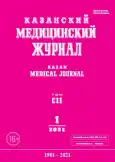Age-related characteristic of human intervertebral discs from normal anatomy’s point of view
- Authors: Makarova VV1,2, Volchihin MV3
-
Affiliations:
- South Ural State Medical University
- Medical and sanitary unit of the Ministry of Internal Affairs of Chelyabinsk region
- Chelyabinsk regional pathoanatomical Bureau
- Issue: Vol 102, No 1 (2021)
- Pages: 30-38
- Section: Experimental medicine
- Submitted: 09.09.2020
- Accepted: 27.01.2021
- Published: 10.02.2021
- URL: https://kazanmedjournal.ru/kazanmedj/article/view/43849
- DOI: https://doi.org/10.17816/KMJ2021-30
- ID: 43849
Cite item
Abstract
Aim. To compare morphological characteristics between anterior and posterior parts of human intervertebral discs, taking into account age.
Methods. Fragments of 36 intervertebral discs C5C6, D5D6, L5S1 anterior parts taken from deceased persons aged 34 to 94 years, median age 61.0 (50.5; 71.8) years were examined. The comparison group consists of histopathological material obtained from 12 patients with radicular syndrome during planned L5S1 microdiscectomies aged 35–77 years, median age 48.5 (43.0; 58.8) years. There were no statistically significant differences in age between the studied groups (p=0.126023). All materials were divided into subgroups depending on the age of the deceased/operated: 34–52 and 60–94 years for material obtained from the deceased; 35–51 and 58–77 years — for material obtained after surgery. The differences between the three groups were examined by the Kruskal–Wallis test, and quantitative indicators in the two groups were compared by Mann–Whitney U-test.
Results. In the anterior part of the intervertebral discs, signs of degenerative-dystrophic changes were noted in all studied samples. All samples of nucleus pulposus and annulus fibrosus were fibrocartilage with no inflammation. Statistically significant differences (р=0.0283) were obtained in the number of isogenous groups of chondrocytes in intervertebral discs C5C6 anterior part compared with D5D6, L5S1 in individuals aged 34–52. Age subgroups (34–52 and 60–94 years old) differed significantly (р=0.0219) in the number of single chondrocytes according to results of morphometry of anterior part of intervertebral discs L5S1. Anterior and posterior parts of intervertebral discs L5S1 differed statistically significant in the number of isogenous groups of chondrocytes when comparing the subgroup of operated patients aged 35–51 years (р=0.008475) with the subgroup of deceased persons aged 34–52 years and the subgroup of operated patients aged 58–77 years (р=0.033753) with the subgroup of deceased aged 60–94 years.
Conclusion. Anterior and posterior part of intervertebral discs L5S1 had similar qualitative histological characteristics; however, the number of isogenous groups of chondrocytes in the posterior part of intervertebral discs L5S1 samples indicated a greater effect of compression loading compared to anterior part of the same spinal motion segment.
Full Text
About the authors
V V Makarova
South Ural State Medical University; Medical and sanitary unit of the Ministry of Internal Affairs of Chelyabinsk region
Author for correspondence.
Email: makarova.nadezhdachel@mail.ru
Russian Federation, Chelyabinsk, Russia; Chelyabinsk, Russia
M V Volchihin
Chelyabinsk regional pathoanatomical Bureau
Email: makarova.nadezhdachel@mail.ru
Russian Federation, Chelyabinsk, Russia
References
- Vo N.V., Hartman R.A., Yurube T. et al. Expression and regulation of metalloproteinases and their inhibitors in intervertebral disc aging and degeneration. Spine J. 2013; 13 (3): 331–341. doi: 10.1016/j.spinee.2012.02.027.
- Vo N.V., Hartman R.A., Patil P.R. et al. Molecular me¬chanisms of biological aging in intervertebral discs. J. Orthopaed. Res. 2016; 34 (8): 1289–1306. doi: 10.1002/jor.23195.
- Pavlova V.N., Kop'eva T.N., Sluckij L.I. et al. Hryashch. (Cartilage.) M.: Medicina. 1988; 320 p. (In Russ.)
- Strukov A.I. Age-related development of the spinal column. In: Anatomicheskie i gistostrukturnye osobennosti detskogo vozrasta. Trudy laboratorii vozrastnoj morfologii gosudarstvennogo central'nogo instituta ohrany zdorov'ya detej i podrostkov NKZ. (Anatomical and histostructural features of childhood. Publications of age-related morpho¬logy laboratory of the State Institute for health protection of children and adolescents.) Ed. by E.Y. Shurpe. M.: Biomedgiz. 1936; 55–123. (In Russ.)
- Kapandzhi A.I. Pozvonochnik: fiziologiyasustavov. (Spine: physiology of joints.) Translation from fr.: E.V. Kishinevskogo. M.: Izdatel'stvo “E”. 2007; 344 p. (In Russ.)
- Lomeli-Rivas A., Larrinua-Betancourt J.E. Biomechanica de la columna lumbar: un enfoque clinic. Acta Ortopedica Mexicana. 2019; 33 (3): 185–191. PMID: 32246612.
- Newell N., Little J.P., Christou A. et al. Biomechanics of the human intervertebral disc: a review of testing techniques and results. J. Mechanical Behav. Biomed. Materials. 2017; 69: 420–434. doi: 10.1016/j.jmbbm.2017.01.037.
- Ozkaya N., Leger D., Golsheyder D. et al. Fundamentals of biomechanics. Equilibrium, motion and deformation. 4th ed. Switzerland: Springer. 2017; 454 p. doi: 10.1007/978-3-319-44738-4.
- Benzakour T., Igoumenou V., Mavrogenis A.F. et al. Current concepts for lumbar disc herniation. Intern. Orthopaed. 2019; 43 (4): 841–851. doi: 10.1007/s00264-018-4247-6.
- Yamaguchi J.T., Hsu W.K. Intervertebral disc herniation in elite athletes. Intern. Orthopaed. 2019; 43 (4): 833–840. doi: 10.1007/s00264-018-4261-8.
- Smith L.J., Nerurkar N.L., Choi K.-S. et al. Degene¬ration and regeneration of the intervertebral disc: lessons from development. Disease Models & Mechanisms. 2011; 4 (1): 31–41. doi: 10.1242/dmm.006403.
- Kurenkov E.L., Makarova V.V., Volchihin M.V. Analysis of age-related morpholo¬gical changes in human intervertebral disc. Meditsinskaya nauka i obrazovanie Urala. 2019; (4): 59–63. (In Russ.)
- Gelli R.L., Spayt D.U., ¬Simon R.R. Neotlozhnaya ortopediya. Pozvonochnik. (Emergency orthopedics. The Sine.) Translation from eng.: R.G. Akzhigitova. M.: Medicina. 1995; 432 p. (In Russ.)
- Zehra U., Noel-Barker N., Marshall J. et al. Associations between intervertebral disc degeneration gra¬ding schemes and measures of disc function. J. Orthopaedic Res. 2019; 37 (9): 1946–1955. doi: 10.1002/jor.24326.
Supplementary files











